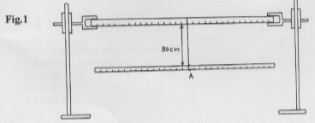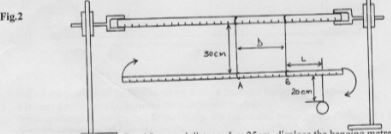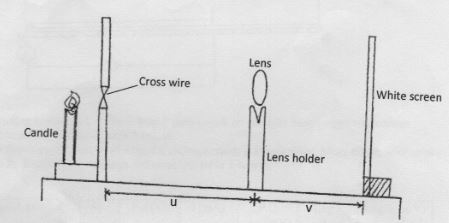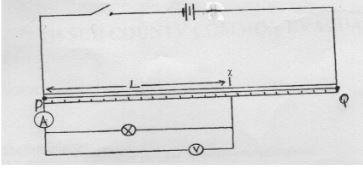Questions
INSTRUCTIONS TO CANDIDATES:
- Answer all the questions in spaces provided in the question paper.
- You are allowed to spend the first 15 minutes of 212 hours allowed for this paper reading the whole paper carefully before commencing the work.
- Marks given for clear record of the observations actually made, their suitability accuracy and the use made of them.
- Candidates are advised to record their observations as soon as they are made.
- Non-programmable silent electronic calculators and KNEC Mathematical table may be used.
- This question consists of two parts A and B; attempt both parts.
- PART A (15 MARKS)
You are provided with the following.- Two metre-rules
- A stop watch
- A half metre-rule
- Two resort stands, two bosses and two clamps.
- Some sewing thread.
- A pendulum bob.
- Proceed as follows:
- Clamp one metre rule horizontally on the two stands so that it is on a vertical plane. Suspend the second metre rule so that it balances on one point as shown in figure 1 below. Note the balance point as the centre of gravity of the metre rule.
Let this be point A. - Set the length of the string on which the metre rule is suspended to be 30cm.
Tie a second support to the metre rule a distance D from the first string.
Let the point of support be point B. - Suspend the pendulum bob with a string a distance L from B and set the length of the string to 20cm.
See figure 2 below.
Starting with a distance D=15cm, and distance L=25cm, displace the hanging metre rule on a horizontal plane and record the time taken for it to make 20 complete oscillations on table 1. - Repeat part (c) above for other values of D and complete the table.
Table 1 (6mks)D(cm) Time for 20 oscillations (s) Periodic time (T) (s) T2 (s2) 15 20 25 30 35 40 - On the grid provided, plot a graph of D (cm) against T2(s2) (5mks)
- Determine the slope of the graph. (2mks)
- Use your graph to determine the periodic time when the length of distance D is 33cm. (2mks)
- Clamp one metre rule horizontally on the two stands so that it is on a vertical plane. Suspend the second metre rule so that it balances on one point as shown in figure 1 below. Note the balance point as the centre of gravity of the metre rule.
- PART B. 5 MARKS
You are provided with the following apparatus:- Candle
- Lens
- Lens holder
- Metre rule
- Screen with a crosswire
- Screen.
Proceed as follows:- Arrange the apparatus as shown in the figure 2 below.
Fig 2 - Place the cross-wire before the lens so that U=28cm. The lit candle should be placed close to the cross-wire.
- Adjust the position of the screen until a sharp image is cast on the screen.
- Measure and record the value distance, V, in the table
- Repeat the same procedure for the other values in the table.
Table 2U(cm) V(cm) M= 30 36 - Given that the focal length f of the lens satisfies the equation f=V1+M, determine the average value of the focal length, f. (2 mks)
- Arrange the apparatus as shown in the figure 2 below.
- PART A (15 MARKS)
- You are provided with the following.
- A switch
- A 100cm nichrome wire mounted on a metre rule.
- An ammeter
- 2 dry cells
- A cell holder
- A bulb of 2.5V mounted on a holder.
- Eight connecting wires (four with crocodile clips at one end)
- Voltmeter (0-3 or 0-5V)
PROCEED AS FOLLOWS.- Connect the apparatus provided as shown in the circuit in figure 3 below.
Fig 3 - Place the sliding contact x at L=20cm from P then switch on and take both current and voltage reading. Record the reading in table 3 above.
- Repeat the above experiment by placing the sliding contact x at each point 40cm, 60cm, 70cm and 80cm from P. Record your readings and complete table 3.
Table 3 (8mks)Length L (cm) I(A) P.d(V) I(mA) P.D(mV) Log l(mA) LOg V(mV) 20 40 60 70 80 - Plot a graph of Log I against Log V. (5mks)
- Determine the slope of the graph. (3mks)
- The relationship between I and P.D is given by the equation.
Log I= n Log V+ Log K where K and n are constants. Determine using the graph the value of:- K (2mks)
- n (2mks)
- Connect the apparatus provided as shown in the circuit in figure 3 below.
Confidential
QUESTION ONE:
Each candidate will require
- Half- metre rule
- Two metre rules (strictly wooden)
- A stop watch
- A piece of sewing thread (thin) 100cm long.
- pendulum bob
- Two retort stand, two bosses and two clamps.
- A lens and a lens holder (focal length 10 cm)
- A candle stick
- A screen
- Screen with a cross-wire
QUESTION TWO
Each candidate will require:
- A 100cm nichrome wire mounted on a metre rule(swg 32)
- A switch
- An ammeter
- Two dry cells
- A cell holder
- A filament bulb of 2.5v mounted on a holder
- Eight connecting wires (four with crocodile clips at one end)
- Voltmeter (0-3V or 0-5V)
Marking Scheme
QUSTION:
| PART 1 | PART II |
| a) Mass m0 of the marble used=6.7g(mass depends on the marble used)(height depends on the amount of water put in the boiling tube) b) Height h1 of the water column=7.8cm |
a) Total lengthl1, of the boiling tube L1=14.5 ± 0.1cm b) (i) Length L2 to the tube above the liquid level l2=3.6+ 0.1cm (ii) length of the tube immersed in the liquid L1-L2 =14.5-3.6=10.9+0.1cm |
| c) New height of h2 of the water column=8.5cm | (c) Mass M of the boiling tube with its content m=48.5+0.1g=0.0485kg |
| d) Internal diameter d of the boiling tube=2.14+ 0.01cm | (d) Outer diameter, d, of the boiling tube D=2.39+0.1cm |
| e) V0=πd(h2-h1)/4 =22/7 x 2.14/4(8.5-7.8)=2.52cm =2.52cm3(3d.p) |
(e) volume vx of the liquid x displaced Vx=π[d/2]2 (l1-l2) 22/7 [2.39/2]2 = 48.93cm (3d.p) |
| f) Density d0=mass m 0/volumevo =6.7/2.66 = 2.66g/cm3 (3d.p) | f) Mass mx of the liquid x displaced Mx=v xℓ =48.92ℓ grams where ℓ is in g/cm3 |
| Weight=48.92l1000x10=0.4892ℓ Newtons | |
| (g)Weight of liquid x displaced = Weight of the boiling tube + its content. 0.4892ℓ=0.485 ℓ=0.485 0.4892 =0.99g/cm3(3d.p) (Range: 0.95-1.05g.cm3) |
QUESTION 2
PART 1
-
-
1mark each to a maximum of 4Length L(m) 0.70 0.60 0.50 0.40 0.30 0.20 Current 1(A) 0.12 0.14 0.16 0.18 0.22 0.28 1/1(A-1) 8.33 7.14 6.25 5.56 4.55 2.78
1/A value-1max for all correct - Graph of 1/1(y-axis) against L.
- Slope S of the graph S=6.75-1.9/0.55-0 = 4.85/0.55 =8.818A-1m-1 (Range:8.375-8.960A-1m-1)
-
- Diameter, d,of the nichrome wire d=0.35 + 0.01mmType equation here.
Download Physics Paper 3 Questions and Answers with Confidentials - Moi Tea Mock Examinations 2022.
Tap Here to Download for 50/-
Get on WhatsApp for 50/-
Why download?
- ✔ To read offline at any time.
- ✔ To Print at your convenience
- ✔ Share Easily with Friends / Students




